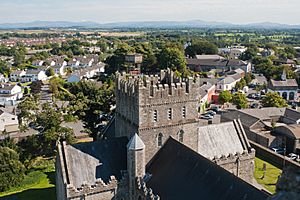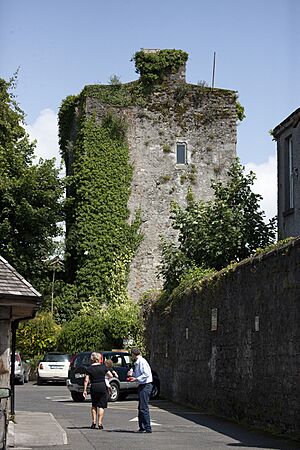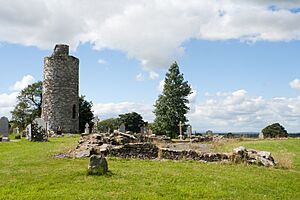Kildare facts for kids
Quick facts for kids
Kildare
Cill Dara
|
|
|---|---|
|
Town
|
|

Saint Brigid's Cathedral and Kildare as seen from the round tower
|
|
| Country | Ireland |
| Province | Leinster |
| County | County Kildare |
| Area | |
| • Total | 3.1 km2 (1.2 sq mi) |
| Elevation | 105 m (344 ft) |
| Population
(2022)
|
|
| • Total | 10,302 |
| • Density | 3,320/km2 (8,610/sq mi) |
| Eircode routing key |
R51
|
| Telephone area code | +353(0)45 |
| Irish Grid Reference | N726124 |
| Historical population | ||
|---|---|---|
| Year | Pop. | ±% |
| 1813 | 1,299 | — |
| 1821 | 1,516 | +16.7% |
| 1831 | 1,753 | +15.6% |
| 1841 | 1,629 | −7.1% |
| 1851 | 1,275 | −21.7% |
| 1861 | 1,399 | +9.7% |
| 1871 | 1,333 | −4.7% |
| 1881 | 1,174 | −11.9% |
| 1891 | 1,172 | −0.2% |
| 1901 | 1,576 | +34.5% |
| 1911 | 2,639 | +67.4% |
| 1926 | 2,116 | −19.8% |
| 1936 | 1,758 | −16.9% |
| 1946 | 2,109 | +20.0% |
| 1951 | 2,286 | +8.4% |
| 1956 | 2,617 | +14.5% |
| 1961 | 2,551 | −2.5% |
| 1966 | 2,731 | +7.1% |
| 1971 | 3,137 | +14.9% |
| 1981 | 4,016 | +28.0% |
| 1986 | 4,268 | +6.3% |
| 1991 | 4,196 | −1.7% |
| 1996 | 4,278 | +2.0% |
| 2002 | 6,893 | +61.1% |
| 2006 | 7,538 | +9.4% |
| 2011 | 8,142 | +8.0% |
| 2016 | 8,634 | +6.0% |
| 2022 | 10,302 | +19.3% |
Kildare is a town in County Kildare, Ireland. Its name, Irish: Cill Dara, means "church of oak." In 2022, about 10,302 people lived there. This makes it the 7th largest town in County Kildare.
Kildare is home to Kildare Cathedral. This cathedral is built on the site of an important abbey. The abbey was founded by Saint Brigid in the 5th century. East of the town, you'll find The Curragh, a famous open grassland.
The town is about 50 kilometers (31 miles) west of Dublin. This makes it a popular place for people who work in Dublin to live. Even though Kildare gives its name to the county, Naas is actually the county town.
Contents
Kildare's Rich History
How Saint Brigid Founded Kildare
Kildare Town has a long and interesting history. It began in the 5th century. This is when Saint Brigid started the first 'Church of the Oak' and a monastery. This place became one of the three most important Christian centers in ancient Ireland.
It is said that Saint Brigid learned about caring for cattle and dairying from her mother. She promised to live a holy life. Then, she and some friends started a community. They built it under an oak tree on a hill near the Curragh. This is why the town is called Cill Dara, meaning "church of the oak."
A story tells that the King of Leinster gave Brigid the land for her community. He offered her as much land as her cloak could cover. When she spread her cloak, it amazingly stretched out to cover the entire Curragh. The King kept his promise. He gave her the fertile plain, where her community raised sheep and cows.
The Carmelite Friary: White Abbey Church
The Carmelite Friars came to Kildare in 1290. They were invited by Lord William de Vesci. He also helped set up the Franciscans in the Grey Abbey. The Carmelites built a church and school in the 1750s. This was after strict laws against Irish Catholics were made easier.
The current Carmelite Church was started in 1884. It was designed in a Gothic style. The church has a cross shape. Its tall spire reaches 40 meters (131 feet) high. Inside, you can see beautiful stained glass windows. They show scenes from the lives of Jesus and Mary. They also show Saints Patrick and Brigid.
Since 2016, Indian Carmelites have been in charge of the church and friary.
Kildare's Role in Early Car Racing
In July 1903, a big car race called the Gordon Bennett Cup took place in Kildare. This was the first international car race ever held in Britain or Ireland. Racing was not allowed on public roads in Britain. So, Ireland was chosen as the location.
An editor from the Dublin Motor News suggested an area in County Kildare. Letters were sent to many people to get support. Kildare was picked partly because its straight roads were safer for racing. To honor Ireland, the British team raced in British racing green. This color became famous. The race was 528 kilometers (328 miles) long. It went through parts of counties Kildare and Carlow, including Kildare town. A Belgian racer named Camille Jenatzy won the race in a Mercedes car.
Fun Places to Visit in Kildare
The Kildare Town Tourist Office & Heritage Centre is in the Market House. St. Brigid's Cathedral and a Norman tower are also in the town center.
Just outside town, you can find St Brigid's Well and Father Moore's Well.
Other popular places to visit near Kildare include:
- The Irish National Stud and Japanese Gardens: A famous horse breeding farm with beautiful gardens.
- Curragh Racecourse: A well-known horse racing track.
- Kildare Village outlet center: A great place for shopping and a popular tourist spot.
Sports Clubs in Kildare
Kildare has several sports clubs for young people and adults.
- Round Towers is a local GAA club. It was started in 1888 and plays in the Kildare GAA league.
- Kildare Town A.F.C. is a local association football (soccer) club. It was founded in 1966.
- Cill Dara RFC is a rugby club that plays in the Leinster League.
- The South Kildare Soldiers are an American Football team. They play in the Irish American Football League.
Getting Around Kildare
Kildare is easy to reach by road. The R445 and M7 roads pass through the town. Several bus services connect Kildare to other places. Aircoach has a service between Dublin and Cork that stops in Kildare. Dublin Coach offers services to Dublin Airport and Portlaoise. There is also a stop at the "Kildare Village" shopping center. Go Ahead Ireland has two services through Kildare: 126 (Dublin-Kildare) and 126e (Dublin-Rathangan).
Kildare railway station is on the main railway line between Dublin and Cork. You can also connect to Waterford from here. Further down the line, you can change trains for Limerick, Galway, Westport, and Ballina. A shuttle bus service runs from the station to "Kildare Village." On race days, there is also a shuttle bus to the Curragh Racecourse.
Famous People from Kildare
Many interesting people have come from Kildare:
- Seamus Aldridge (born 1935): A Gaelic games administrator and former Gaelic football referee.
- Aisling Bea (born 1984): A well-known actress, comedian, and writer.
- Brigid of Kildare (451-525): The founder of the famous monastery in Kildare.
- Michèle Burke (born 1959): A makeup artist who has won two Oscars. She was born in Kildare town.
- George Cooper (1792–1867): The first Colonial Treasurer of New Zealand. He was born in Kildare.
- Ray D'Arcy (born 1964): A popular presenter for the RTE's show Ray D'Arcy Show.
- David Egan (born 1999): A talented jockey.
Images for kids
See also
 In Spanish: Kildare para niños
In Spanish: Kildare para niños







